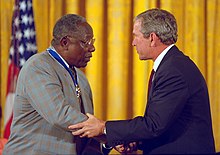Hank Aaron
[15] On November 20, 1951, baseball scout Ed Scott signed Aaron to a contract on behalf of the Indianapolis Clowns of the Negro American League, where he played for three months.
[18] As a result of his standout play with the Indianapolis Clowns, Aaron received two offers from MLB teams via telegram, one from the New York Giants and the other from the Boston Braves.
Of a time his team was in Washington, D.C. Aaron recalled: We had breakfast while we were waiting for the rain to stop, and I can still envision sitting with the Clowns in a restaurant behind Griffith Stadium and hearing them break all the plates in the kitchen after we finished eating.
Even as a kid, the irony of it hit me: here we were in the capital in the land of freedom and equality, and they had to destroy the plates that had touched the forks that had been in the mouths of black men.
Former Braves minor league player and sportswriter Pat Jordan said, "Aaron gave [Geraghty] much of the credit for his own swift rise to stardom.
The Braves were able to speak to the draft board, making the case that Aaron could be the player to integrate the Southern Association the following season with the Atlanta Crackers.
"[18] On March 13, 1954, Milwaukee Braves left fielder Bobby Thomson fractured his ankle while sliding into second base during a spring training game.
The next day, Aaron made his first spring training start for the Braves major league team, playing in left field and hitting a home run.
[14] This led Aaron to a major league contract, signed on the final day of spring training, and a Braves uniform with the number five.
The nickname quickly gained currency, but "Henry" continued to be cited frequently in the media, both sometimes appearing in the same article, and Aaron would answer to either one.
During his rookie year, his other well-known nicknames, "Hammerin' Hank" (by teammates) and "Bad Henry" (by opposing pitchers) are reported to have arisen.
Considerably later in his career, Aaron coined "Stone-fingers", which would prove a popular handle for one of baseball's more colorful characters, the famously distance-hitting but defensively challenged first baseman Dick Stuart,[38] reportedly "delight[ing]" even its recipient.
[1] On September 23, 1957, in Milwaukee, Aaron hit a two-run walk-off home run against the St. Louis Cardinals, clinching the pennant for the Braves.
[1] Aaron himself downplayed the "chase" to surpass Babe Ruth, while baseball enthusiasts and the national media grew increasingly excited as he closed in on the 714 career home runs record.
Aaron received thousands of letters every week during the summer of 1973, including hate mail; he ended up asking a secretary working for the Braves, Carla Koplin, to help him sort through it.
But in his final game that year, playing against the Houston Astros (managed by Leo Durocher, who had once roomed with Babe Ruth), he was unable to achieve this.
[54] He was the recipient of death threats and a large assortment of hate mail during the 1973–1974 offseason from people who did not want to see Aaron break Ruth's nearly sacrosanct home run record.
While preparing the massive coverage of the home run record, Grizzard quietly had an obituary written, afraid that Aaron might be murdered.
Or will it be remembered as the season in which Aaron, the most dignified of athletes, was besieged with hate mail and trapped by the cobwebs and goblins that lurk in baseball's attic?
In August 1973, Peanuts cartoonist Charles Schulz drew a series of strips in which Snoopy attempts to break Babe Ruth's record, only to be besieged with hate mail.
[58] Babe Ruth's widow, Claire, denounced the racism and declared that her husband would have enthusiastically cheered Aaron's attempt at the record.
He played two out of three and tied Babe Ruth's record on April 4, 1974, in his first at-bat on his first swing of the season—off Reds pitcher Jack Billingham, but did not hit another home run in the series.
In the fourth inning, Aaron hit home run number 715 off Los Angeles Dodgers pitcher Al Downing.
While cannons were fired in celebration, two college students sprinted onto the field and jogged alongside Aaron for part of his circuit around the bases, temporarily startling him.
[66] Minor league right-handed pitcher Roger Alexander was sent to the Braves to complete the transaction at the Winter Meetings one month later on December 2.
"[81] The former name came around when Don Davidson, the public relations director for the Milwaukee Braves, began to refer to him as such in an effort to make the quiet, soft-spoken player seem more accessible to the fans and the press.
[86] Aaron indeed attended Friendship Baptist Church toward the end of his life, noting in his autobiography that he didn't remain a practicing Catholic for very long after converting.
Many current or former athletes and team owners such as MLB Commissioner Rob Manfred, Magic Johnson, David Ortiz, Dusty Baker, Eduardo Pérez, Mike Trout, and Baseball Hall of Fame chairman Jane Forbes Clark paid tribute to him.
There is also a statue of him as an 18-year-old shortstop outside Carson Park in Eau Claire, Wisconsin, where he played his first season in the Braves' minor league system.
The alternative high school had been named after Nathan Bedford Forrest, a general in the Confederate Army and the Ku Klux Klan's first Grand Wizard.










